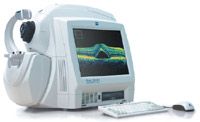Article
'High-definition ocular coherence tomography update adds age-related macular degeneration, glaucoma tools
Author(s):
New software (version 6.0) introduced for a proprietary high-definition ocular coherence tomography platform provides researchers and clinicians an expanded set of diagnostic tools to use in the evaluation and management of patients with AMD and glaucoma.

Key Points
New software (version 6.0) introduced for a proprietary high-definition ocular coherence tomography (OCT) platform (Cirrus HD-OCT, Carl Zeiss Meditec) provides researchers and clinicians an expanded set of diagnostic tools to use in the evaluation and management of patients with age-related macular degeneration (AMD) and glaucoma.
The company announced Jan. 20 that it received that offers several new capabilities. It includes the Advanced Retinal Pigment Epithelium (RPE) Analysis software that has dual applications for objective monitoring of changes associated with dry AMD. The software measures and tracks changes in the area and volume of RPE elevations, which may be associated with drusen, as well as identifies and measures the area of RPE loss, which is associated with geographic atrophy.


Philip J. Rosenfeld, MD, PhD, professor of ophthalmology, Bascom Palmer Eye Institute, was the clinical leader of the group developing the techniques.
"We are very excited about this groundbreaking work that was initiated at our institution, which has culminated in commercial availability of these algorithms to clinicians," he said. "The new software for the analysis of geographic atrophy measures the true area of anatomic involvement and thereby differs from assessment with fundus autofluorescence, which measures the presence or absence of autofluorescent material, rather than the true anatomic absence of the RPE. In addition, unlike blue light fundus autofluorescence, the . . . HD-OCT measurements of geographic atrophy are not affected by macular pigment in the fovea."
Newsletter
Don’t miss out—get Ophthalmology Times updates on the latest clinical advancements and expert interviews, straight to your inbox.
2 Commerce Drive
Cranbury, NJ 08512
All rights reserved.





